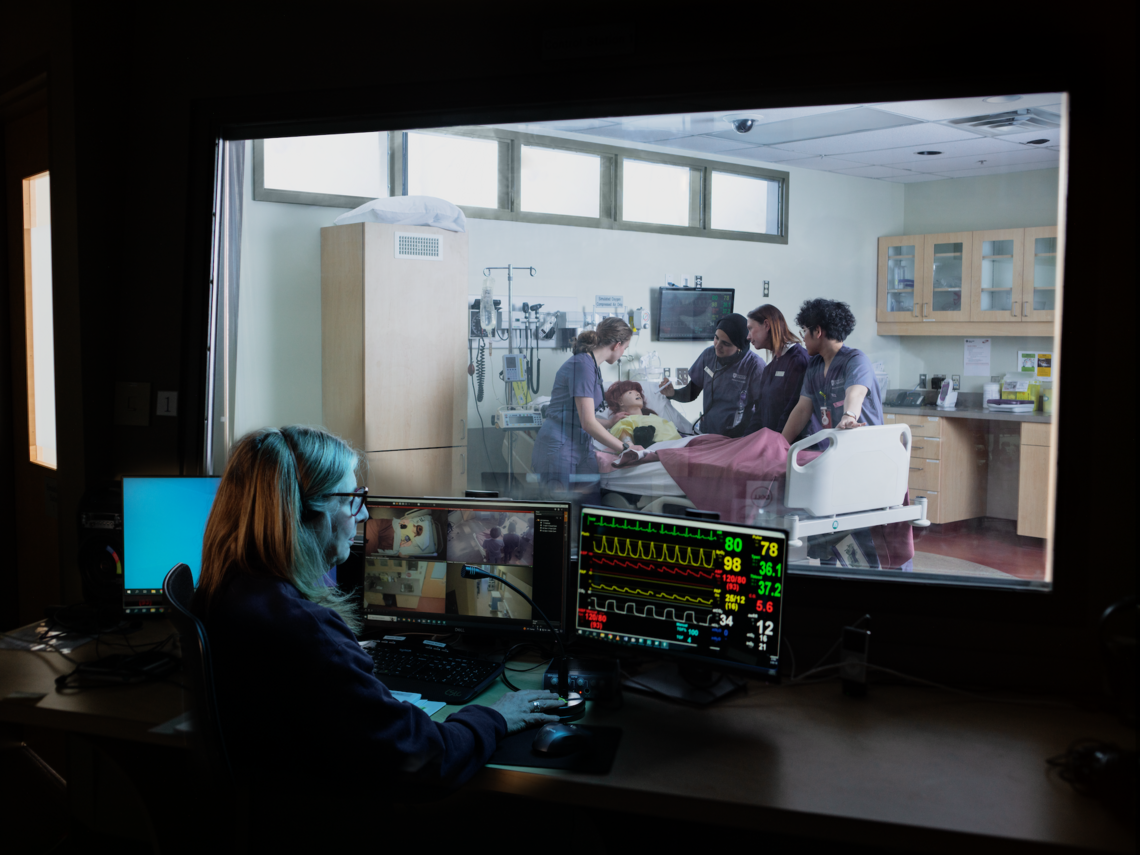Interactive Video Novel (IVN)
A choose-your-own-adventure orientation to simulation in the Clinical Simulation Learning Centre for nursing students at UCalgary
Summary
This project presents a timely and innovative solution to address a critical need in nursing education: effective and engaging pre-simulation preparation. By leveraging technology, incorporating student voices, and adhering to best practices, the project aims to enhance the Simulation-based learning (SBL) experience, improve student learning outcomes and contribute to the advancement of nursing education at the University of Calgary and beyond.
(Audio in this recording was generated using Google’s NotebookLM)
Technology Integrated Learning Team (TILT)

Navigate our Interactive Video-Novel Demo
Check out our interactive demo, a "choose-your-own-adventure" orientation to simulation in the CSLC at the Faculty of Nursing.
"Preparing students for healthcare simulation is critical, aligned with best practice, and improves learning outcomes more than established methods or no preparation, as agreed by experts" (McDermott et al., 2021; Sokol, 2022; Tyerman, 2019).

Setting the Stage: Why This Matters
Simulation-based learning (SBL) is crucial for developing core nursing competencies such as clinical skills and critical reasoning.
Challenges: Students often find SBL overwhelming due to inadequate preparation, impacting their performance and satisfaction.
Gaps Identified: Unfamiliarity with the simulation environment and principles can negatively affect students, especially in rural, remote, and Indigenous settings.
The Need for Innovation: Our Starting Point
Current Issues: The UCalgary Nursing Clinical Simulation Learning Centre (CSLC) lacks accessible resources to prepare students for the simulation environment.
Proposed Solution: An interactive video-novel (IVN) series and social media supplements to introduce students to simulation principles and practices.
Goals: To provide consistent, high-quality pre-simulation orientation that enhances student preparedness and reduces stress.

Description of Innovation
Interactive Video-Novel (IVN): A multimedia tool using video, audio, and text to create an immersive learning environment.
Features: Includes storytelling, gamification, and multimedia elements to engage students and introduce them to the simulation environment.
Supplementary Social Media Series: Provides additional information, tips, and resources to support the IVN.
Real-World Impact: Making a Difference
Enhanced Preparedness: Students will be better prepared for SBL, leading to improved performance and satisfaction.
Consistency and Accessibility: The IVN series ensures all students receive the same quality of preparation, regardless of location.
Broader Reach: The project promotes experiential learning, inclusion, and accessibility, benefiting not only UCalgary Nursing but also external institutions.
Outcomes and Benefits: What We’ve Achieved So Far and Next Steps
Completed: Project Planning, Script Writing and Storyboard Design, Video Filming.
Next Steps: Video Editing, Adding Interactive Elements, Web Integration and Social Media Channels Development, Pilot Testing.
Future Goals: Launch the IVN series, gather feedback, and continuously improve the tool based on user experience and outcomes.
Afify, M. K. (2020). Effect of interactive video length within e-learning environments on cognitive load, cognitive achievement and retention of learning. Turkish Online Journal of Distance Education, 21(4), 68-89.
Agic, B., Fruitman, H., Maharaj, A., Taylor, J., Ashraf, A., Henderson, J., ... & Sockalingam, S. (2022). Advancing curriculum development and design in health professions education: a health equity and inclusion framework for education programs. Journal of Continuing Education in the Health Professions, 10-1097. DOI: 10.1097/CEH.0000000000000453
Association for Experiential Education. (2023). What is Experiential Education?
Cumming, T. M., & Rose, M. C. (2022). Exploring universal design for learning as an accessibility tool in higher education: A review of the current literature. The Australian Educational Researcher, 49(5), 1025-1043.
Doughty, R. (2021, Feb 16). The future of online learning: the long-term trends accelerated by Covid-19. The Guardian. The future of online learning: the long-term trends accelerated by Covid-19 | Postgraduates | The Guardian
Center for Medical Simulation. (n.d.). The basic assumption. Harvard.
Koukourikos, K., Tsaloglidou, A., Kourkouta, L., Papathanasiou, I. V., Iliadis, C., Fratzana, A., & Panagiotou, A. (2021). Simulation in clinical nursing education. Acta Informatica Medica, 29(1), 15. doi: 10.5455/aim.2021.29.15-20
McDermott, D. S., Ludlow, J., Horsley, E., & Meakim, C. (2021). Healthcare simulation standards of best practiceTM pre-briefing: preparation and briefing. Clinical Simulation in Nursing, 58, 9-13.
Priyakanth, R., Abburi, R., & Praveena, M. (2021). Design and impact of interactive video content for the improvement of student engagement and learning. Journal of Engineering Education Transformations, 34, 518-523.
Purdy, E., Symon, B., Marks, R. E., Speirs, C., & Brazil, V. (2023). Exploring equity, diversity, and inclusion in a simulation program using the SIM-EDI tool: the impact of a reflexive tool for simulation educators. Advances in Simulation, 8(1), 11.
Queen’s University. (2021). Simulation-based Experiential Learning Faculty Toolkit. Experiential Learning Hub. Simulation EL Faculty Toolkit Final April 8.pdf (queensu.ca)
Rao, K., Gravel, J., Rose, D., & Tucker-Smith, N. (2023). Universal Design for Learning in its 3rd decade: A focus on equity, inclusion, and design. International encyclopedia of education, 712-720. DOI: 10.1016/b978-0-12-818630-5.14079-5
Silva, G. O., e Oliveira, F. S., Coelho, A. S. G., Cavalcante, A. M. R. Z., Vieira, F. V. M., Fonseca, L. M. M., ... & Aredes, N. D. A. (2022). Effect of simulation on stress, anxiety, and self-confidence in nursing students: Systematic review with meta-analysis and meta-regression. International Journal of Nursing Studies, 133, 104282.
Sokol, K. (2022 Dec 2). Healthcare Simulation Scenarios: Why Preparation is Essential for Learners. Healthy Simulation.
Tyerman, J., Luctkar-Flude, M., Graham, L., Coffey, S., & Olsen-Lynch, E. (2019). A systematic review of health care pre-simulation preparation and briefing effectiveness. Clinical Simulation in Nursing, 27, 12-25.
University of Calgary. (2023). Ahead of tomorrow: 2023-30 strategic plan.
Wong, J. K., Oladinrin, O. T., Ho, C. M., Guilbert, E., & Kam, R. (2022). Assessment of video-based e-learning in a construction measurement course. International Journal of Construction Management, 22(1), 1-7.
This project is funded by a 2024 University of Calgary Teaching and Learning Grant.
Take a deeper dive into our project
Project Planning and Literature Review: Conducting a thorough review of relevant literature on SBL, pre-briefing strategies, storytelling, gamification, and multimedia production.
Script Writing and Storyboard Design: Collaboratively developing the IVN's script and storyboard, incorporating student input and feedback.
Video Filming and Editing: Creating high-quality video content using real and virtual representations of the CSLC, ensuring clarity, coherence, and adherence to multimedia best practices.
Interactive Elements Development: Designing and integrating engaging interactive elements within the IVN, enhancing student learning and information retention.
Web Integration and Social Media Channels Development: Making the IVN series accessible through the CSLC webpage and accompanying social media content, ensuring user-friendliness and ongoing accessibility.
Pilot Testing and Program Implementation: Piloting the IVN series with a group of undergraduate students, incorporating feedback, and launching the program for all new nursing students.
Ongoing Evaluation and Dissemination: Continuously evaluating the IVN series' effectiveness through student feedback, disseminating findings through publications, conferences, and online platforms
Enhancing SBL Preparedness: Reducing student anxiety, increasing confidence, and improving overall performance in simulations.
Promoting Accessibility and Consistency: Providing a standardized and accessible pre-orientation tool for all UCalgary Nursing students across different learning sites.
Advancing Innovation in Nursing Education: Establishing a benchmark for immersive learning experiences and disseminating best practices to other institutions.
The project's impact will be sustained beyond the funding period through:
Curriculum Integration: Incorporating the IVN series into the existing and future nursing curriculum.
Faculty Training: Equipping Nursing instructors and facilitators to effectively utilize the IVN series in supporting student learning.
Ongoing Evaluation and Improvement: Continuously updating the IVN series based on student feedback and emerging best practices in SBL.
The Health Equity and Inclusion Framework for Education and Training to guide project design and execution.
The SIM-EDI tool to promote reflexivity and awareness of EDI issues within the simulation context.
Inclusive language, diverse representation, and accessible design in all project materials.
EDI-sensitive evaluation methods to assess the project's impact on all learners.
Meet the Team
Principal investigator: Justin Burkett, Faculty of Nursing
Co-investigators: Amber Porter, Kayla Dias, Karen Cook, Lynda Sea, Tammy Hnatyshyn, Faculty of Nursing

From left, Kayla Dais, Lynda Sea, Justin Burkett, Karen Cook, Amber Porter
Learn more about the technology and equipment in our Clinical Learning Simulation Centre at the Faculty of Nursing
